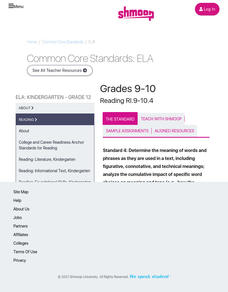Curated OER
World War I Art and Artists
Young scholars examine the art of World War I. In this World War I art lesson, students research paintings and artists of the era. Young scholars role play the artists they research and explain their lives and paintings to their classmates.
Virginia Department of Education
Developing an essay: Using specific nouns, strong verbs, and vivid adjectives
Feeling bored and unimpressed with word choice in your class? If so, consider this activity, which focuses on using specific and precise language. Pupils use highlighters, brainstorm independently and in small groups, and create a poster...
Curated OER
The Personal Narrative - Part Two
Does your langauge arts class journal frequently? Extend one of your journaling activities by having your writers choose a journal entry and take it through the five stages of writing. They will use the attached graphic organizer to...
Curated OER
Lots of Lessons from Aesop
Aesop’s Fables offer young learners an opportunity to study figurative language. After reviewing theme, simile, alliteration, and metaphor, model for your pupils how to identify examples of these devices in the fable. Class members then...
Curated OER
An Imaginary Creature And Then Using Describing And Action Words for a Creative Writing Exercise
You have to collect lots of materials (boxes, bags, toilet paper rolls, etc.) for this lesson to work successfully. After modeling how to create an imaginary creature out of the collection of recycled materials, let your class search...
Curated OER
Cover It Up!
Students use their artistic skills to create a unique report cover that reflects the report's content. They combine their art and a written report to design an interesting and original presentation. The erasing technique presented can be...
Curated OER
Friendship
Learners investigate the concept of friendship as part of a four lessons unit which integrates literature with language arts, family life, social studies, or religious studies. Peace, cooperation, social justice, and multicultural...
Curated OER
Silent Stories
Students create a pictorial narrative based upon John Keats' "Ode on a Grecian Urn" and the Japanese techniques of "lacquer jar" stories in this three-day Language Arts/Art lesson.
Curated OER
In Our Own Voice
Students, after being introduced to poetry in the language arts class, prepare to produce a product by identifying and writing a variety of different types of poetry. They utilize digital cameras, camcorders, computers and the multimedia...
Curated OER
Can We Switch Genders of Story Characters?
Students read and review the main elements of a story. In this language arts lesson, students predict what the story read to them would have been like if the genders of the characters had been different. Students write a new story in...
Curated OER
Using Adjectives
In this language arts lesson plan, young scholars listen to the book "Many Luscious Lollipops," in order to become familiar with adjectives. Students create four comic strip squares, using five adjectives in each square, after
hearing...
Curated OER
Why Koala Has A Stumpy Tail
First graders read the story Why Koala Has A Stumpy Tail and complete language arts activities with it. Students have discussions, read, write, spell, and act out the story.
Curated OER
Enormous Turnips
First graders complete activities with the story The Great Big Enormous Turnip by Alexel Tolstoy. In this language arts lesson, student view the story as a Cloze passage and work with a partner to fill in the blanks. They check to make...
Curated OER
Education, Design & Empowerment: Part One
Students consider the connection between poverty and education. In this language arts and social studies lesson plan, students research primary and secondary sources in order to explore the relationship between education and poverty.
Curated OER
Can Diet and Exercise Help?
Young scholars research information on diabetes. In this health and or language arts lesson, students develop Power Point presentations to demonstrate how life style choices affect the risk of developing diabetes. This is a great...
Curated OER
Can You Figure Language?
Eighth graders study similes and metaphors and how to explain and create them. After a lecture/demo, 8th graders access websites and worksheets imbedded in this plan to create their own writing.
Curated OER
Stories in Quilts
Have your class analyze the narrative art in quilts. They identify elements in this domestic art and the stories they tell. They define a story quilt, view an example, and analyze the work of Harriet Power. This is a great lesson to...
Curated OER
The Talking Stick
Learners examine the lives of the Aboriginal peoples of Saskatchewan. In this talking stick lesson, students discover dance, art, music, and traditions of the First Nations people. Learners design and create a talking stick to represent...
Curated OER
Sharing is Caring
By engaging in an arts-based activity, 2nd graders explore peace in the classroom. They listen to the story The Rainbow Fish, then create their own fish to hang in the classroom. They write three things that make them happy on their...
Shmoop
ELA.CCSS.ELA-Literacy.RI.9-10.4
Your pupils will be expected to determine the meaning of words and how those words affect the meaning of a text. Help them master this skill with the ideas listed here. First, look over the two activities that could be used for your...
Curated OER
Eating Up Idioms
Ah, food idioms! Now that sounds tasty. Class members read and discuss various food-related idioms, create an illustration of a food-related idiom, and develop a class book or bulletin board to celebrate figurative language and National...
Curated OER
What's the Weather Like? Primary Level
Elementary schoolers and language learners will shine with a series of games and activities that feature weather words. The exercises can be adapted for pairs, small groups, or whole class participation.
Curated OER
Theater: Create a Script
Figurative language is the focus in the book Teach Us, Amelia Bedelia. After reading Peggy Parish's book, class members dramatize idioms from the text, using dramatic strategies such as characterization, exaggeration, and improvisation....
Baruch College Writing Center
Summarizing, Paraphrasing, and Quoting Workshop
What's the difference between summarizing and paraphrasing? Show class members how to find the main ideas from informational text and condense it, restate it, or quote it directly with a series of educational activities based on two...
Other popular searches
- 5th Grade Language Arts
- 3rd Grade Language Arts
- 4th Grade Language Arts
- Second Grade Language Arts
- English Language Arts
- 1st Grade Language Arts
- Kindergarten Language Arts
- Language Arts Jeopardy Game
- First Grade Language Arts
- Language Arts School Projects
- Language Arts Lesson Plans
- Language Arts Games

























